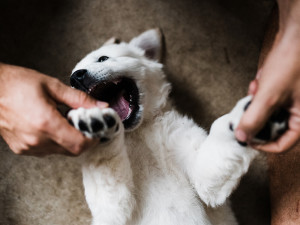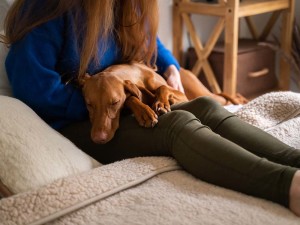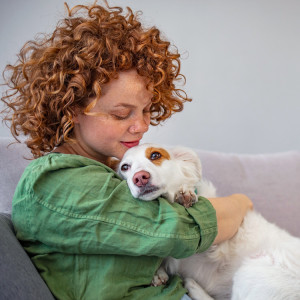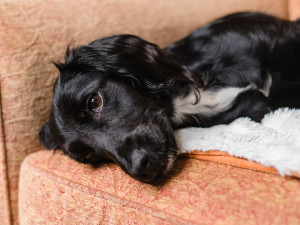Parvovirus: How to Identify and Treat Parvo Symptoms in Puppies
The potentially deadly virus can be prevented with one simple step
Here is yet another reason to make sure your dog is up-to-date on their vaccinations: they’ll avoid a potentially deadly virus known as canine parvovirus (CPV) or ‘parvo’. Most commonly found in puppies who haven’t been vaccinated yet, parvo messes with your dog’s gastrointestinal tract and can lead to dangerous levels of dehydration and malnutrition. Here’s everything you need to know, including the symptoms to look out for and the preventative steps you can take.
What is parvovirus in dogs?
Canine parvovirus (CPV), often referred to as parvo, is a highly contagious and potentially deadly virus that affects a dog’s intestinal tract. Not only does parvovirus in dogs have a high mortality rate if left untreated; it can survive in the environment for months, or even years, in the right conditions.
Parvovirus in dogs mostly affects pups with weak immune systems, including puppies and unvaccinated dogs. Puppies are especially vulnerable to parvo infections during the gap between immunity from their mother’s milk and when they are fully vaccinated at 12-16 weeks oldopens in new tab. Dogs with existing autoimmune deficiencies are also at greater risk.
How is parvo transmitted in dogs?
The parvovirus enters the dog’s body through contact with the mucus membranes, then spreads in the lymphatic system and bloodstream. An infected dog sheds the parvovirus through faeces, so transmission of parvo can occur when other dogs come in contact with those faeces directly (via their nose or mouth), or indirectly (by touching contaminated items).
Another way the parvovirus is transmitted in dogs is by being passed along on multiple surfaces, including fur, food bowls, toys, kennels and bedding, and dirt and grass contaminated by infected faeces. A dog with parvo can start shedding the virus as soon as four days after exposure, often before symptoms begin to manifest and before they are known to be infected.
What are parvo symptoms in dogs?
Common parvo symptoms and signs in dogs include:
diarrhoea, often bloody
hypothermia (below-normal temperature)
lethargy
weight loss
bloated and/or painful abdomen
If you observe any of these symptoms in your dog, it’s crucial that you take them to the vet as soon as possible, as most deaths from parvo occur within 48 to 72 hours after symptoms begin.
Can dogs survive parvo?
Many parents are curious: how long does parvo last in dogs? And is it survivable? With proper veterinary care, the survival rate of dogs who contract parvo can be up to 90 percent, but without treatment, the mortality rate is more than 80 percent.
How is parvo in dogs diagnosed?
A veterinarian diagnoses parvo by taking the dog’s history, noting the dog’s clinical signs and performing an examination; samples of stool and blood are also required. The diagnosis is then confirmed by lab testing of the samples. This parvovirus test for dogs is essential to begin treatment as soon as they have been diagnosed.
What are the stages of parvo in dogs?
There are six stages of parvo in dogs: the first is exposure, when the dog is exposed to an infected dog, though sometimes it can be shedded within three weeks through their poo. Second is the incubation period, which lasts three to five days. After five to eight days, symptoms usually start to present (see above). The next stage is diagnosis by a vet – it‘s important to get your dog to the doctor as soon as possible if you suspect parvo because it can be deadly if left untreated. Then treatment (see below) followed by recovery during this time, which can take 14 to 20 days; it’s important to keep your dog isolated and disinfect their things so the infection doesn’t spread.
How is parvo in dogs treated?
Treatment for parvo in dogs includes:
intravenous fluids to combat dehydration and replenish electrolytes
anti-nausea medication
antibiotics to prevent secondary bacterial infection
isolation
temperature control to prevent hypothermia
There is no cure for parvo at this time, but studies involving the use of antibody therapies that target the virus are currently being conducted and have promising results.
Specifically, puppies are most susceptible to parvo from six weeks until six months. So, is there medicine for parvo in puppies? If your puppy is diagnosed, your vet may put them on an antibiotic medication to combat bacterial infections and will monitor your puppy for additional complications.
How much does parvo treatment cost?
Parvo treatment costs vary but can reach thousands of poundsopens in new tab for all of the tests and treatment, including overnight stays if necessary.
How to prevent parvo in dogs
The best way to keep dogs safe is to make sure they are up-to-date on their vaccines. Puppies should be given the parvo vaccine (DHLPP) starting at six to eight weeks of age. After that, the vet will give your dog booster vaccines every year.
Other important points: before they’re fully vaccinated, puppies should be kept away from areas that could potentially be contaminated with parvo, such as parks, pet shops and groomers. Don’t allow them to play with other dogs unless those dogs have been fully vaccinated.
Indoor areas where dogs congregate should be fully disinfected with dilute bleach or other commercial products. Faecal matter should be removed from both indoor and outdoor spaces as well. It’s important to note that even after dogs recover from parvo, they can still be contagious for up to two weeks so it’s best to keep them away from other dogs until after that time has passed.
The bottom line: good hygiene and preventive measures will go a long way towards keeping your dog healthy and safe.
Frequently asked questions
Can adult dogs get parvo?
Yes, adult dogs can get parvo if they are unvaccinated. If a dog has a compromised immune system, they are also at risk for parvo.
How can parvo be prevented?
The best way to keep dogs safe is to make sure they are up-to-date on their vaccines. Puppies should be given the parvo vaccine (DHLPP) starting at six to eight weeks of age.
Is parvo contagious to humans or other animals?
The virus can’t be spread from pet to person, but it can be spread from dogs to other wild animals, including foxes.
What is the fastest way to cure parvo?
Get your dog or puppy to the vet ASAP – IV fluids and management of electrolytes are the most important treatment. Antibiotics are given to prevent secondary infections.
What food can cure parvo in puppies?
It can be tough to get your puppy to eat or drink if they are sick with parvo. Follow your vet’s recommendation for food and ensuring they are hydrated.









